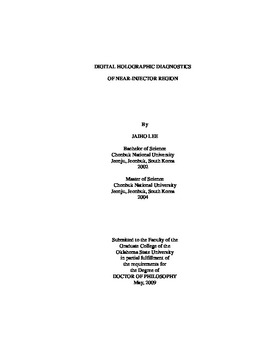| dc.contributor.advisor | Sallam, Khaled A. | |
| dc.contributor.author | Lee, Jaiho | |
| dc.date.accessioned | 2013-12-10T18:05:18Z | |
| dc.date.available | 2013-12-10T18:05:18Z | |
| dc.date.issued | 2009-05 | |
| dc.identifier.uri | https://hdl.handle.net/11244/7802 | |
| dc.description.abstract | Scope and Method of Study: The primary breakup of near-injector region of liquid jets is of interest motivated by its application to gas turbine fuel injectors, diesel fuel injectors, industrial cleaning, medical spray, and inkjet printers, among others. The dense spray region near the injector is optically obscure for Phase Doppler Interferometer. Moreover, two-dimensional methods, e.g. shadowgraphy, have limited depth-of-field that renders them impractical for measuring droplet sizes and velocities of three-dimensional spray structure. The main objective of this study is to investigate the dense spray near the injector region of liquid jets using digital holography. The digital microscopic holography (DMH) was used for drop size and velocity measurements of the breakup of aerated liquid jets. Digital microscopic holography (DMH) is similar to digital inline holography (DIH) except that no lens is used to collimate the object beam. Two Nd:YAG lasers were used to generate two independent laser pulses, and the laser beams were expanded with an objective lens and a spatial filter. This eliminates two lenses from the typical optical path used for in-line holography, which results in a much cleaner hologram recording. | |
| dc.description.abstract | Findings and Conclusions: Using a commercial grade CCD for the DMH, the cost of CCD sensor needed for recording holograms could be reduced. The dense spray region of aerated liquid jets in crossflow was investigated using the DMH (test condition: 1mm jet diameter, 8% GLR, and qo=0.74). The spray structure of aerated liquid jets was obtained by patching several high resolution holograms. Droplet velocities in three dimensions were measured by tracking their displacements in the streamwise and cross-stream direction and by tracking the change in the plane of focus in the spanwise direction. The distributions of the streamwise and cross-stream velocities were uniform in the near-injector region and could be characterized by the mass-average velocity except for very small and very large droplets. Double view DMH reduced the uncertainty of spatial measurements in the spanwise direction. | |
| dc.format | application/pdf | |
| dc.language | en_US | |
| dc.rights | Copyright is held by the author who has granted the Oklahoma State University Library the non-exclusive right to share this material in its institutional repository. Contact Digital Library Services at lib-dls@okstate.edu or 405-744-9161 for the permission policy on the use, reproduction or distribution of this material. | |
| dc.title | Digital holographic diagnostics of near-injector region | |
| dc.contributor.committeeMember | Ghajar, Afshin J. | |
| dc.contributor.committeeMember | Chambers, Frank W. | |
| dc.contributor.committeeMember | Ackerson, Bruce J. | |
| osu.filename | Lee_okstate_0664D_10312.pdf | |
| osu.accesstype | Open Access | |
| dc.type.genre | Dissertation | |
| dc.type.material | Text | |
| dc.subject.keywords | breakup | |
| dc.subject.keywords | digital holography | |
| dc.subject.keywords | droplet | |
| dc.subject.keywords | liquid jet | |
| dc.subject.keywords | smd | |
| dc.subject.keywords | spray | |
| thesis.degree.discipline | Mechanical Engineering | |
| thesis.degree.grantor | Oklahoma State University | |
